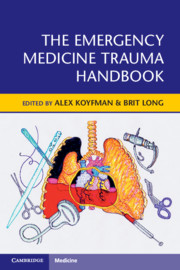Book contents
- The Emergency Medicine Trauma Handbook
- The Emergency Medicine Trauma Handbook
- Copyright page
- Contents
- Contributors
- Preface
- Disclaimer
- Chapter 1 General Approach to Traumatic Injuries
- Chapter 2 Trauma Airway
- Chapter 3 Transfusion in Trauma
- Chapter 4 Trauma in Pregnancy
- Chapter 5 Pediatric Trauma
- Chapter 6 Geriatric Trauma
- Chapter 7 Head Trauma
- Chapter 8 Facial Trauma
- Chapter 9 Eye Trauma
- Chapter 10 Cervical Spine Trauma
- Chapter 11 Thoracolumbar Trauma
- Chapter 12 Neck Trauma
- Chapter 13 Pulmonary Trauma
- Chapter 14 Cardiac Trauma
- Chapter 15 Abdominal and Flank Trauma
- Chapter 16 Genitourinary Trauma
- Chapter 17 Peripheral Vascular Injury
- Chapter 18 Pelvic Trauma
- Chapter 19 Upper Extremity Trauma
- Chapter 20 Lower Extremity Trauma
- Chapter 21 Burns and Electrical Injuries
- Chapter 22 Procedural Sedation and Analgesia in Trauma
- Chapter 23 Commonly Missed Traumatic Injuries
- Index
- References
Chapter 23 - Commonly Missed Traumatic Injuries
Published online by Cambridge University Press: 23 August 2019
- The Emergency Medicine Trauma Handbook
- The Emergency Medicine Trauma Handbook
- Copyright page
- Contents
- Contributors
- Preface
- Disclaimer
- Chapter 1 General Approach to Traumatic Injuries
- Chapter 2 Trauma Airway
- Chapter 3 Transfusion in Trauma
- Chapter 4 Trauma in Pregnancy
- Chapter 5 Pediatric Trauma
- Chapter 6 Geriatric Trauma
- Chapter 7 Head Trauma
- Chapter 8 Facial Trauma
- Chapter 9 Eye Trauma
- Chapter 10 Cervical Spine Trauma
- Chapter 11 Thoracolumbar Trauma
- Chapter 12 Neck Trauma
- Chapter 13 Pulmonary Trauma
- Chapter 14 Cardiac Trauma
- Chapter 15 Abdominal and Flank Trauma
- Chapter 16 Genitourinary Trauma
- Chapter 17 Peripheral Vascular Injury
- Chapter 18 Pelvic Trauma
- Chapter 19 Upper Extremity Trauma
- Chapter 20 Lower Extremity Trauma
- Chapter 21 Burns and Electrical Injuries
- Chapter 22 Procedural Sedation and Analgesia in Trauma
- Chapter 23 Commonly Missed Traumatic Injuries
- Index
- References
Summary
The terms “missed injury” and “delayed diagnosis” have undergone evolution in their academic meaning over the last several decades of trauma care. Missed injury is typically reserved for an unidentified injury for which the opportune moment for intervention has passed. A delayed diagnosis is the term given to injuries not identified on the primary or secondary survey of the initial trauma evaluation. There is obvious overlap in the ways these terms are employed throughout trauma care, and specific institutions may possess their own interpretations. Many emergency medicine texts list a missed injury as one that is discovered after the patient has left the Emergency Department (ED), whether discharged home or admitted. This version of the “missed injury definition” would include possible injuries which were suspected in the ED (not truly “missed”), though not officially found due to appropriate delays in imaging while more acute issues are being resolved in the operating room (OR) or Intensive Care Unit (ICU). The national trauma database of the American College of Surgeons defines missed injury as an “injury-related diagnosis discovered after initial workup is completed and admission diagnosis is determined.”1 Delayed diagnosis was proposed to describe diagnoses that were not found on primary and secondary survey. The tertiary survey was intended to identify many of these injuries,2 though some literature still defines injuries found during the tertiary survey as “delayed.”3,4 In any case, the use of a tertiary survey should be employed in all trauma evaluations, as it leads to a reduction in clinically significant initially unidentified injuries.5 Trauma surgery has also created leveling algorithms based on the mechanism of injury to help activate appropriate resources for trauma patients. Finally, multiple evidence-based decision tools (i.e. Ottawa knee rules, Canadian head computed tomography rules, etc.) exist to help delineate imaging decisions.
- Type
- Chapter
- Information
- The Emergency Medicine Trauma Handbook , pp. 334 - 346Publisher: Cambridge University PressPrint publication year: 2019



